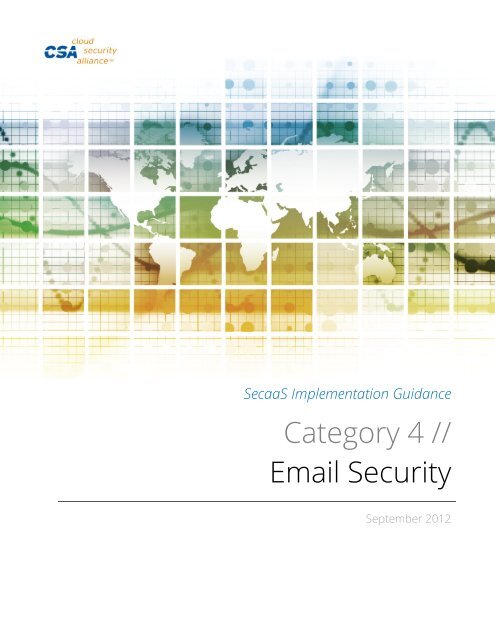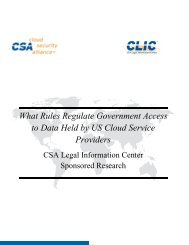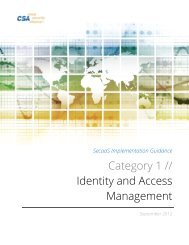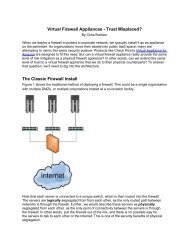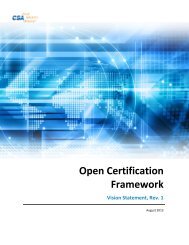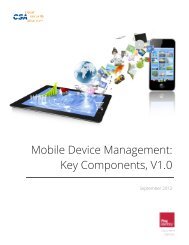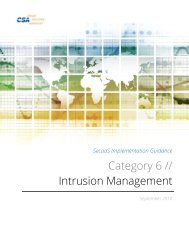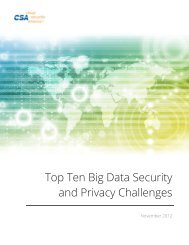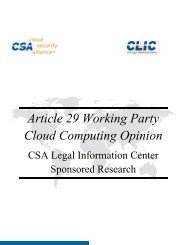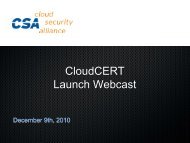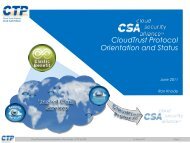Email Security Implementation Guidance - Cloud Security Alliance
Email Security Implementation Guidance - Cloud Security Alliance
Email Security Implementation Guidance - Cloud Security Alliance
- No tags were found...
You also want an ePaper? Increase the reach of your titles
YUMPU automatically turns print PDFs into web optimized ePapers that Google loves.
SecaaS <strong>Implementation</strong> <strong>Guidance</strong>Category 4 //<strong>Email</strong> <strong>Security</strong>September 2012
CLOUD SECURITY ALLIANCE SecaaS <strong>Implementation</strong> <strong>Guidance</strong>, Category 4: <strong>Email</strong> <strong>Security</strong>© 2012 <strong>Cloud</strong> <strong>Security</strong> <strong>Alliance</strong>All rights reserved. You may download, store, display on your computer, view, print, and link to the <strong>Cloud</strong><strong>Security</strong> <strong>Alliance</strong> <strong>Security</strong> as a Service <strong>Implementation</strong> <strong>Guidance</strong> at http://www.cloudsecurityalliance.org,subject to the following: (a) the <strong>Guidance</strong> may be used solely for your personal, informational, non-commercialuse; (b) the <strong>Guidance</strong> may not be modified or altered in any way; (c) the <strong>Guidance</strong> may not be redistributed; and(d) the trademark, copyright or other notices may not be removed. You may quote portions of the <strong>Guidance</strong> aspermitted by the Fair Use provisions of the United States Copyright Act, provided that you attribute the portionsto the <strong>Cloud</strong> <strong>Security</strong> <strong>Alliance</strong> <strong>Security</strong> as a Service <strong>Implementation</strong> <strong>Guidance</strong> Version 1.0 (2012).© Copyright 2012, <strong>Cloud</strong> <strong>Security</strong> <strong>Alliance</strong>. All rights reserved. 2
CLOUD SECURITY ALLIANCE SecaaS <strong>Implementation</strong> <strong>Guidance</strong>, Category 4: <strong>Email</strong> <strong>Security</strong>ContentsForeword ....................................................................................................................................................................5Letter from the Co-Chairs ...........................................................................................................................................6Acknowledgments ......................................................................................................................................................71.0 Introduction ..........................................................................................................................................................81.1 Intended Audience ...........................................................................................................................................81.2 Scope ................................................................................................................................................................92.0 Requirements Addressed .................................................................................................................................. 102.1 Business Value ............................................................................................................................................... 102.1.1 Leveraging Message Aggregation ........................................................................................................... 102.1.2 Rapid Response ...................................................................................................................................... 112.1.3 On Demand Provisioning ........................................................................................................................ 112.1.4 Advanced Skillset .................................................................................................................................... 112.2 Key Challenges in Migration of E-Mail to the <strong>Cloud</strong> ...................................................................................... 112.2.1 Data <strong>Security</strong> and Protection .................................................................................................................. 112.2.2 Regulatory Compliance........................................................................................................................... 122.2.3 Data Residency ....................................................................................................................................... 122.2.4 Unauthorized Disclosure ........................................................................................................................ 122.3 Solutions Roadmap ........................................................................................................................................ 122.3.1 Standards-Based ..................................................................................................................................... 132.3.2 Malware and Spam Protection ............................................................................................................... 132.3.3 Identity and Encryption .......................................................................................................................... 132.3.4 Secure Access ......................................................................................................................................... 142.3.5 Integration with Data Asset Protection Systems .................................................................................... 142.3.6 Records Retention/Data Destruction ..................................................................................................... 142.3.7 System Management and Logging ......................................................................................................... 143.0 <strong>Implementation</strong> Considerations and Concerns ................................................................................................. 153.1 Considerations ............................................................................................................................................... 153.1.1 Multi-Tenancy ......................................................................................................................................... 153.1.2 Portability ............................................................................................................................................... 15© Copyright 2012, <strong>Cloud</strong> <strong>Security</strong> <strong>Alliance</strong>. All rights reserved. 3
CLOUD SECURITY ALLIANCE SecaaS <strong>Implementation</strong> <strong>Guidance</strong>, Category 4: <strong>Email</strong> <strong>Security</strong>3.1.3 Programmatic Access ............................................................................................................................. 153.1.4 Self-Service ............................................................................................................................................. 153.1.5 Client Controls ........................................................................................................................................ 163.1.6 Management and Monitoring ................................................................................................................ 163.1.7 Integration .............................................................................................................................................. 163.2 Concerns ........................................................................................................................................................ 163.2.1 Data <strong>Security</strong> .......................................................................................................................................... 163.2.2 Regulatory Compliance........................................................................................................................... 173.2.3 Data Disclosure ....................................................................................................................................... 173.2.4 Data Residency ....................................................................................................................................... 173.2.5 Identity ................................................................................................................................................... 183.2.6 Logging .................................................................................................................................................... 183.2.7 Communications ..................................................................................................................................... 184.0 Architecture and <strong>Implementation</strong> Steps ........................................................................................................... 194.1 Architecture Overview ................................................................................................................................... 194.1.1 Fully Outsourced <strong>Email</strong> <strong>Implementation</strong> ................................................................................................ 204.1.2 <strong>Email</strong> <strong>Security</strong> <strong>Cloud</strong> Augmentation to Premise Enterprise <strong>Implementation</strong>s ...................................... 204.2 <strong>Guidance</strong> and <strong>Implementation</strong> Steps ............................................................................................................ 224.2.1 Client <strong>Security</strong> ......................................................................................................................................... 224.2.2 Administration ........................................................................................................................................ 234.2.3 Submission End-Point, the Mail Submission Agent ................................................................................ 234.2.4 Mail Delivery Agent ................................................................................................................................ 234.2.5 Mail Transfer Agent ................................................................................................................................ 244.2.6 Mail Storage ............................................................................................................................................ 24© Copyright 2012, <strong>Cloud</strong> <strong>Security</strong> <strong>Alliance</strong>. All rights reserved. 4
CLOUD SECURITY ALLIANCE SecaaS <strong>Implementation</strong> <strong>Guidance</strong>, Category 4: <strong>Email</strong> <strong>Security</strong>Foreword<strong>Cloud</strong> Computing represents one of the most significant shifts in information technology manyof us are likely to see in our lifetimes. We are reaching the point where computing functions as a utility,promising innovations yet unimagined. The major roadblock to full adoption of <strong>Cloud</strong> Computing has beenconcern regarding the security and privacy of information.Much work has been done regarding the security of the cloud and data within it, but until now, there have beenno best practices to follow when developing or assessing security services in an elastic cloud model—a modelthat scales as client requirements change.One mission of the <strong>Cloud</strong> <strong>Security</strong> <strong>Alliance</strong> is to provide education on the uses of <strong>Cloud</strong> Computing to helpsecure all other forms of computing. To aid both cloud customers and cloud providers, the CSA SecaaS WorkingGroup is providing <strong>Implementation</strong> <strong>Guidance</strong> for each category of <strong>Security</strong> as a Service, as delineated in theCSA’s SecaaS Defined Categories of Service. <strong>Security</strong> as a Service was added, as Domain 14, to version 3 of theCSA <strong>Guidance</strong>.<strong>Cloud</strong> <strong>Security</strong> <strong>Alliance</strong> SecaaS <strong>Implementation</strong> <strong>Guidance</strong> documents are available athttps://cloudsecurityalliance.org/research/working-groups/security-as-a-service/.We encourage you to download and review all of our flagship research at http://www.cloudsecurityalliance.org.Best regards,Jerry Archer Alan Boehme Dave CullinaneNils Puhlmann Paul Kurtz Jim ReavisThe <strong>Cloud</strong> <strong>Security</strong> <strong>Alliance</strong> Board of Directors© Copyright 2012, <strong>Cloud</strong> <strong>Security</strong> <strong>Alliance</strong>. All rights reserved. 5
CLOUD SECURITY ALLIANCE SecaaS <strong>Implementation</strong> <strong>Guidance</strong>, Category 4: <strong>Email</strong> <strong>Security</strong>Letter from the Co-Chairs<strong>Security</strong> as a Service is a specialized area categorized two years ago as growing rapidly and in unboundpatterns. Vendors were struggling. Consumers were struggling. Each offering had its own path. We felt it wasurgent to address the needs and concerns common to the implementation of <strong>Security</strong> as a Service in its manyforms.The Defined Categories of Service helped clarify the functionalities expected from each Category. In this series,we hope to better define best practices in the design, development, assessment and implementation of today’sofferings.We want to thank all of the many contributors worldwide who have worked so hard to produce these papersproviding guidance for best practices in <strong>Cloud</strong> Computing <strong>Security</strong>. Many have been with the <strong>Security</strong> as aService Working Group since the beginning; many others joined in this effort. Each has spent countless hoursconsidering, clarifying, writing and/or editing these papers. We hope they help move forward toward thoseunimagined innovations.Sincerely,Kevin Fielder and Cameron SmithSecaaS Working Group Co-Chairs© Copyright 2012, <strong>Cloud</strong> <strong>Security</strong> <strong>Alliance</strong>. All rights reserved. 6
CLOUD SECURITY ALLIANCE SecaaS <strong>Implementation</strong> <strong>Guidance</strong>, Category 4: <strong>Email</strong> <strong>Security</strong>AcknowledgmentsChairMark Hahn, TCB Technologies, Inc.ContributorsMarcelo Carvalho, FATEC-SPYael Nishry, VaultiveYogesh Paliwal, CiscoPaul Pottorff, Faster MotionAdam Swidler, GooglePeer ReviewersVarun Badhwar, Cipher<strong>Cloud</strong>Dennis Dayman, EloquaTim O'Brien, Tata Steel GroupRon Poserina, SymantecCSA Global StaffLuciano JR Santos, Research DirectorJohn Yeoh, Research AnalystAaron Alva, Research InternVicki Hahn, Technical Writer/EditorKendall Scoboria, Graphic DesignerEvan Scoboria, Webmaster© Copyright 2012, <strong>Cloud</strong> <strong>Security</strong> <strong>Alliance</strong>. All rights reserved. 7
CLOUD SECURITY ALLIANCE SecaaS <strong>Implementation</strong> <strong>Guidance</strong>, Category 4: <strong>Email</strong> <strong>Security</strong>1.0 IntroductionElectronic mail now plays a vital role in business interactions among customers, partners and internal staff. Itallows data and messages to be transferred easily between senders and receivers over the Internet or internalnetworks, allowing messages to be received, responded to, stored, forwarded and broadcast among recipients.These extensive capabilities have caused email to be widely adopted as the official communications method formany organizations. Also common for personal use, electronic mail is available thru a diverse number ofcompatible software clients, and also via web-browser.Due to its ubiquitous use, electronic mail is both the prime target of, and primary vehicle for, attacks, and mustbe protected on both ends: sending and receiving. <strong>Email</strong> service is a well-defined utility in the enterprise, andsecuring email in the cloud is similar to securing email in the enterprise. <strong>Email</strong> <strong>Security</strong> as a Service (SecaaS) hasa few unique aspects, but most responses entail differences of degree, rather than instituting new methods ofsecurity.<strong>Email</strong> security services conform to one of two service models: fully outsourced and enterprise augmentation.The first service model outsources the entire mailbox and user interface to a cloud provider (either in a singletenantor multi-tenant model). The second service model adds security processing to an existing enterpriseemail implementation. In a fully outsourced model, the service provider is responsible for monitoring all threatsusing email as a channel (spam, phishing, malware propagation, etc.), and for providing an email user interface(UI) and possibly assistance to an organization's end users. In the enterprise augmentation model, an existingon-premise email deployment is augmented by additional cloud-based services and functionalities.This paper explores both common forms of usage and additional extended services (such as identity federationand data loss prevention), and describing best practices for evaluating, developing, installing and using cloudbasedemail security services.1.1 Intended Audience<strong>Email</strong> security services are viewed from two perspectives: the providers of these services and the consumers orpurchasers of email security services. Both sides need to be aware of and plan for key service features and howthese features are used to mitigate threats to email security.Section 2 provides an executive level overview of email security services and delivery methodologies, and showshow security threats are mitigated in a cloud-based service versus a traditional self-hosted solution. Section 3presents considerations and concerns that should be part of any conversation regarding the use of <strong>Email</strong><strong>Security</strong> as a Service. Section 4 is a technical discussion of typical architectures and the implementation of <strong>Email</strong>SecaaS using current best practices as defined by the industry. Section 5 provides lists of both references anduseful links to supplement this information© Copyright 2012, <strong>Cloud</strong> <strong>Security</strong> <strong>Alliance</strong>. All rights reserved. 8
CLOUD SECURITY ALLIANCE SecaaS <strong>Implementation</strong> <strong>Guidance</strong>, Category 4: <strong>Email</strong> <strong>Security</strong>1.2 ScopeThis paper discusses the use of SecaaS services to mitigate email threats arising from viruses, phishing, spam,denial of service and operational disruptions. Features covered are email digital signatures, encryption, emailarchival services, threat detection and prevention services and data loss prevention (DLP). One best practicearound email services in the cloud is the use of a federated identity system to ensure proper authenticity ofmessages and service users.The scope of this document includes secure implementation of electronic mail services on cloud architectures,including:• Common electronic mail components• Electronic mail architecture protection• Common electronic mail threats• Peer authentication• Electronic mail message standards• Electronic mail encryption and digital signature• Electronic mail content inspection and filtering• Securing mail clients• Electronic mail data protection and availability assurance techniques© Copyright 2012, <strong>Cloud</strong> <strong>Security</strong> <strong>Alliance</strong>. All rights reserved. 9
CLOUD SECURITY ALLIANCE SecaaS <strong>Implementation</strong> <strong>Guidance</strong>, Category 4: <strong>Email</strong> <strong>Security</strong>2.0 Requirements Addressed<strong>Email</strong> is a primary mechanism by which information is created and exchanged within and betweenorganizations. <strong>Email</strong> services and email protection services are largely commoditized so all solutions, cloudbasedor non-cloud-based, follow a similar model.<strong>Cloud</strong>-based vendors may be able to provide organizations with compelling value propositions for fullyoutsourced email, or for security augmentation services for in house enterprise email implementations. Onemajor advantage to cloud-based security is that large vendors can view the aggregated traffic from manyorganizations, and thereby have early indications and insights into new types of malware and spam floods. Thisbenefit is not available to a single tenant outsourced or single enterprise implementation, which will have torespond after being affected, or await alerts from other sources.2.1 Business Value<strong>Cloud</strong>-based vendors offer organizations many methods of securing email services using specialized skills andtools. Organizations utilizing <strong>Email</strong> SecaaS offerings can:• Obtain early response to new forms of malware or spam floods, because their vendor’s multi-tenantmodel allows them access to message traffic across multiple organizations.• Receive rapid deployment of new configurations and updated filtering algorithms because the vendor isable deploy changes which apply to all clients.• Utilize on-demand provisioning for increasing or decreasing usage, thereby eliminating the need forexcess capacity for seasonal or unusual events.• Utilize the specialized skills and techniques that vendors have developed without investing training andexpense in a non-core competency.2.1.1 Leveraging Message AggregationWhen considering cloud-based services, it is often a concern that the multi-tenant model presents risks to dataprotection. However, with email traffic filtering, this multi-tenant model increases the power of the solution. Acloud <strong>Email</strong> <strong>Security</strong> as a Service provider is able to correlate message traffic trends and data across multiplesources for many organizations. This provides the cloud service provider with tremendous insight into currentthreats and intelligence about changing threat models.This capability is simply not available to an organization that operates an enterprise email system in a singletenant manner. A single tenant or completely in house enterprise email system will never be as effective unlessit is augmented with services utilizing a multi-tenant model.© Copyright 2012, <strong>Cloud</strong> <strong>Security</strong> <strong>Alliance</strong>. All rights reserved. 10
CLOUD SECURITY ALLIANCE SecaaS <strong>Implementation</strong> <strong>Guidance</strong>, Category 4: <strong>Email</strong> <strong>Security</strong>2.1.2 Rapid ResponseThe email threat landscape changes rapidly as malware writers and spam operators change tactics to evadefilter systems. This arms race results in a need to rapidly deploy new techniques and configurations. <strong>Cloud</strong>basedvendors provide rapid response because they only have to deploy changes once to their infrastructure toprovide improvements for many clients. In this way, an organization can take advantage of a cloud-basedvendor’s ability to test and deploy new solutions versus having to investigate, test and deploy the changesindividually. This removes the latency many email systems experience in response to changes in threats.2.1.3 On Demand Provisioning<strong>Email</strong> is a key organizational asset and must be available quickly for new users. This usually means anorganization must build in excess capacity in anticipation of future demands. There always is a significantamount of underutilized capacity at any one time, which increases costs. Further, a failure to properly predictfuture demand will leave an organization with an unstable email system which limits the effectiveness of a keybusiness asset.Because cloud-based vendors’ growth is the aggregated demand across many organizations, their growthpredictions can be more precise and capacity can be reliably added in advance of demand. Organizations whoseneeds decrease can easily deprovision services and reduce costs. In this way, costs for a cloud-based solutionmore accurately track the usage curve, making them easier to manage financially.2.1.4 Advanced SkillsetFor most organizations, the implementation and operation of an email system is a business need but not a corecompetency. For cloud-based email and email security vendors, the email system is their core competency andtherefore they are able to hire experts in the field and dedicate full time, trained staff to the function.In order to have the best trained engineers working on highly efficient email security solutions, an organizationmay need to turn to a specialized vendor. These vendors likely will be offering a cloud-based, multi-tenantmodel for their service offerings. SecaaS vendors may offer the most effective solutions to address the emailneeds of an organization.2.2 Key Challenges in Migration of E-Mail to the <strong>Cloud</strong>2.2.1 Data <strong>Security</strong> and ProtectionThe cloud introduces a broad range of security threats, including the possibility of the cloud provider beinghacked, the potential for malicious actions by a rogue employee of the cloud provider, and the intermingling ofdata in a compromised multi-tenant environment.© Copyright 2012, <strong>Cloud</strong> <strong>Security</strong> <strong>Alliance</strong>. All rights reserved. 11
CLOUD SECURITY ALLIANCE SecaaS <strong>Implementation</strong> <strong>Guidance</strong>, Category 4: <strong>Email</strong> <strong>Security</strong>2.2.2 Regulatory ComplianceEnterprises are subject to an array of regulatory requirements including: US federal laws with both domesticand international applications, such as Sarbanes-Oxley (SOX) or The Patriot Act; varying national data protectionmeasures; international requirements like the European Union Data Protection Directive; and industry-specificregulations (e.g., HIPAA, GLBA and PCI DSS). There also are a number of good practices and standards (e.g.,COSO, COBIT, NIST, ISO, etc.) that enterprises adhere to in order to best protect data.2.2.3 Data ResidencyBusinesses that have an international presence are faced with the daunting task of complying with the multitudeof growing privacy and data residency regulations. To comply, enterprises often pay cloud computing providersa premium to add costly infrastructure in each jurisdiction.2.2.4 Unauthorized Disclosure<strong>Cloud</strong> providers may be required to comply with legal processes seeking access to private emails and accountinformation, such as search warrants, national security letters or subpoenas. Under many circumstances,organizations may not even be notified of this disclosure of their key business correspondence.2.3 Solutions Roadmap<strong>Email</strong> security addresses an organization’s needs to provide secure messaging systems for the exchange ofinformation between personnel. <strong>Email</strong> SecaaS addresses many requirements for information security. Theserequirements include:• The ability to send and receive email in standard formats and protocols• Prevention of malware infections via email• Removal of unwanted spam messages• Strong identification of email users• Securing clients and securing remote access to email• Integration with Data Loss Prevention tools• Retention of email records• Encryption of emails at-rest in cloud providers’ environments with secure key management• Mail management and logging• Sender authentication frameworks<strong>Email</strong> <strong>Security</strong> as a Service is provided either as a fully outsourced email service or as specific solutions whichaugment an existing enterprise email implementation. In a fully outsourced implementation, the vendorprovides both the email service and the security features in a single solution. In the enterprise add-on solution,an organization augments an in-house email implementation with security services from cloud-based securityvendors.© Copyright 2012, <strong>Cloud</strong> <strong>Security</strong> <strong>Alliance</strong>. All rights reserved. 12
CLOUD SECURITY ALLIANCE SecaaS <strong>Implementation</strong> <strong>Guidance</strong>, Category 4: <strong>Email</strong> <strong>Security</strong>Using a cloud provider, an organization should be able to add or remove features or services in small incrementson demand, using a single vendor or multiple vendors. This greatly increases flexibility and responsiveness tochanging environments and demands.2.3.1 Standards-BasedIn any implementation, the security vendor should use industry standard formats and protocols for messagingand message transmission. In particular, all industry standard email protocols have TLS/SSL (Transport Layer<strong>Security</strong> / Secure Sockets Layer) versions that allow the use of strong encryption to protect all traffic (mailboxpasswords as well as message bodies). Vendors should use the encrypted forms of all email protocols for accessto, and transmission of, email messages. These protocols should be configured with options which disallowknown weak encryption algorithms (DES, MD5 hashes) and options for strong user authentication.Vendors should adopt operational methods which adhere to industry standards and best practices.Infrastructure should be deployed and built to pass strong physical security standards such as SSAE 16 (or theolder SAS 70) so that the service foundations can be trusted. Further, guidance should be followed for theproper maintenance of services. This guidance can take the form of the COBIT, COSO, ISO 27000, CSA <strong>Guidance</strong>,or industry regulations such as HIPAA, Sarbanes-Oxley and others.2.3.2 Malware and Spam ProtectionMalware and spam protection are the primary threats to the operation of an email system. Vendors provide avariety of solutions to mitigate these threats. Use of an in house or single tenant hosted email system limits theeffectiveness of any solution. In a multi-tenant cloud-based solution, the cloud-based security provider is ableto correlate message traffic across multiple organizations to get richer data regarding malware and spam floods,which in turn provides earlier detection with greater accuracy.As <strong>Email</strong> <strong>Security</strong> as a Service vendors gain intelligence from multiple streams of message traffic and theresulting larger data sets, they are able to rapidly deploy responses and algorithm changes to manyorganizations at once. This quick response is of benefit to all organizations using that vendor.2.3.3 Identity and EncryptionThe security of the overall email system, whether fully outsourced or enterprise hosted and augmented withsecurity services, is driven first by securing the individual components to industry standards and organizationalpolicy.<strong>Cloud</strong> vendors should provide methods which allow the integration into the organization’s identity managementsystems. This integration is described in the SecaaS Category 1 // Identity and Access Management<strong>Implementation</strong> <strong>Guidance</strong>. In the fully outsourced model, cloud vendors should also provide native strongauthentication mechanisms, such as two-factor authentication.© Copyright 2012, <strong>Cloud</strong> <strong>Security</strong> <strong>Alliance</strong>. All rights reserved. 13
CLOUD SECURITY ALLIANCE SecaaS <strong>Implementation</strong> <strong>Guidance</strong>, Category 4: <strong>Email</strong> <strong>Security</strong>2.3.4 Secure Access<strong>Cloud</strong>-based vendors must provide a strong infrastructure and allow access to email systems using only secured(encrypted) protocols. As mentioned before, the SSAE 16 standard provides a report on the controls a vendoruses to manage their operations.Users access email from a variety of devices, and vendors must provide controls which allow the usersconvenient but secure access. Use of encrypted protocols including HTTPS and IMAPS should be required for allaccess from all devices whether it is a PC, a laptop or a mobile device.2.3.5 Integration with Data Asset Protection Systems<strong>Email</strong> messages are a convenient method for moving data inside an organization and to an organization’spartners. However, this convenience also creates difficulties for controlling the distribution of confidentialinformation. <strong>Email</strong> vendors should allow the integration of encryption at-rest and data loss prevention tools toprotect the organization from unauthorized leakage or transfer of sensitive data.The use of Data Loss Protection tools is described in SecaaS Category 2 // Data Loss Prevention <strong>Implementation</strong><strong>Guidance</strong>.2.3.6 Records Retention/Data Destruction<strong>Email</strong> messages often are critical business documents that need to be protected and retained for specificperiods. Many of these documents relate to critical business decisions and discuss matters that are covered byregulations, laws and the organization’s by-laws. An email system should provide methods to specify therecords retention policy, and also completely remove digital copies of documents as desired or required.Vendors should ensure that media on which email messages are stored are indeed erased and overwritten,rather than just returned to “free space.” This requirement is especially critical for vendors using a multi-tenantmodel, because of the potential for data leakage events due to the re-use of storage that was not properlyerased, or other factors.2.3.7 System Management and LoggingVendors must provide management tools for provisioning, configuration and operations management. Toolsavailability should be included in the Service Level Agreement (SLA) so an organization can properly managetheir services. It is important that logging be provided so that unusual events can be properly investigated asthe need arises. <strong>Cloud</strong>-based <strong>Email</strong> <strong>Security</strong> as a Service vendors will differentiate themselves by providing easyto use tools with powerful features for management, reporting and incident investigation.© Copyright 2012, <strong>Cloud</strong> <strong>Security</strong> <strong>Alliance</strong>. All rights reserved. 14
CLOUD SECURITY ALLIANCE SecaaS <strong>Implementation</strong> <strong>Guidance</strong>, Category 4: <strong>Email</strong> <strong>Security</strong>3.0 <strong>Implementation</strong> Considerations and Concerns<strong>Email</strong> security is a relatively mature field, but due to the ubiquitous nature of email, it is a common attack vectorfor malware and scams. <strong>Security</strong> as a Service vendors can use cloud scale and on-demand resources to analyzeincoming email for malware and respond to fluctuations in mail message loads.When evaluating cloud-based services for email security it is important to give due care and research into anumber of different aspects of the service model, as described below.3.1 Considerations3.1.1 Multi-TenancyAs with many cloud services, consideration should be given to how customer data is segregated in a multitenantenvironment. <strong>Cloud</strong> service providers should implement processes and technologies which prevent theinteraction of customer environments. Vendors should implement controls which satisfy the requirements of anSSAE 16 audit. These audits provide customers with assurance that their data is properly safeguarded.3.1.2 PortabilityWhen choosing a vendor, the vendor’s migration tools should be evaluated to ensure they provide the necessarycapabilities. It is important that the vendor offer manageable methods to switch to the provider, switchbetween vendors, or switch back to an in-house service.3.1.3 Programmatic AccessVendors should provide a methodology for programmatic access to the email security system. Possibly, byleveraging a provider’s Application Programming Interface (API), an organization can create tools whichintegrate the email and email security systems into existing workflows and monitoring capabilities.Programmatic access allows an organization great flexibility and enables very responsive on-demand featuressuch as a fully automated workflow for provisioning and deprovisioning of users or services.3.1.4 Self-ServiceAs much as possible, the services provided should encompass end-user self-service tools as well asadministration tools. On-demand workloads enabled by cloud services work best when all users have the abilityto create and extend the services. Such tools might be the creation of email lists or automatic forwarding ofemails. Management controls should allow each organization to choose which features are offered to users, asdifferent organizations may have different policies surrounding various capabilities.© Copyright 2012, <strong>Cloud</strong> <strong>Security</strong> <strong>Alliance</strong>. All rights reserved. 15
CLOUD SECURITY ALLIANCE SecaaS <strong>Implementation</strong> <strong>Guidance</strong>, Category 4: <strong>Email</strong> <strong>Security</strong>3.1.5 Client ControlsMany vendors allow for centralized control of system features, particularly those features relating to security.For example, many smartphone email clients allow the email server to control the user’s choices for screen lockpasswords and remote data removal. It may be the policy of an organization that a user enable screen lock ontheir phone before receiving mail, or allow the email system to remove data (“remote wipe”) from a phone thathas been lost. These sorts of controls should be included features in an email security service offering.3.1.6 Management and MonitoringAn email security service should provide features for management and operations. Management featuresinclude the ability to increase or decrease services, monitor loads and perform configuration changes, amongothers. The management toolset should allow the monitoring of traffic, current levels of malware and spambeing detected and user patterns.3.1.7 IntegrationThe cloud service vendor should integrate and allow integration of various subsystems. Subsystems includemalware detection, spam protection, data loss prevention, content filtering, email encryption, monitoring andreporting. The ability to integrate other services into the email handling pipeline allows an organization to builda best of breed solution with the most effective tools available.3.2 ConcernsThere are a number of concerns or challenges to be solved when implementing email security. An organization’spolicies or regulatory environment may give rise to different choices to resolving the concerns below.3.2.1 Data <strong>Security</strong>Data should be secured at all times by the email service. Encryption should be used for data at rest, data intransit and data in use. Encryption keys should be retained by the organization and not the cloud provider.Protection of the data in only some stages of the data lifecycle does not adequately secure the data and leaves itvulnerable to attack.3.2.1.1 Data at RestEncryption should be used to protect Data at Rest, i.e., data while stored in the email system or extendedarchival systems.3.2.1.2 Data in TransitData in Transit includes data transiting from an end user endpoint computer (e.g., laptop) on the Internet to aweb-facing email service provider in the cloud or amount various email system components (i.e. between theMail Transfer Agent and an <strong>Email</strong> Anti-Virus filtering system provided by a <strong>Cloud</strong>-Based provider).© Copyright 2012, <strong>Cloud</strong> <strong>Security</strong> <strong>Alliance</strong>. All rights reserved. 16
CLOUD SECURITY ALLIANCE SecaaS <strong>Implementation</strong> <strong>Guidance</strong>, Category 4: <strong>Email</strong> <strong>Security</strong>3.2.1.3 Data in UseData in Use refers to the actual processing of data in computer memory, in addition to on-screen display andpresentation of data. It is common for systems that use encryption when storing or transmitting data to decryptdata for processing (e.g., searching or indexing). It is best practice to use algorithms and tools which limit theamount of data needing decryption for searching and indexing. These tools use tokenization or decrypt only keyfields which increase the safeguards on the email data. Research algorithms for full searching of encrypted dataoffer more safeguards; fully homomorphic encryption remains in the future.3.2.2 Regulatory ComplianceAn organization which is covered by specific regulatory guidelines (such as a financial institution or agovernment agency) will need to ensure that the vendor’s infrastructure and operational policies meet theimposed regulatory guidelines. This may eliminate certain vendors, or specific offerings from other vendors.Of special note should be data retention requirements. If using a cloud service provider for email storage, thecosts for archived data should be properly calculated. If costs become prohibitive or if the vendor has storagelimits that prevent long term retention, a separate archiving solution must be considered which will change theeconomics of the cloud-based solution.3.2.3 Data DisclosureIdeally, there is a segregation of duties between the customer, which owns the data, and the <strong>Email</strong> <strong>Cloud</strong> ServiceProvider, which hosts and processes the data. For encrypted data, at any stage of the data lifecycle, thecustomer should retain control of the encryption keys. This principle of segregation, which renders the datahosted by the provider as useless cypher text, enables the customer to be involved in all cases in which the datais subpoenaed, as the keys to decrypting the data are held exclusively by the customer.3.2.4 Data ResidencyRegulatory Compliance leads to further challenges regarding Data Residency controls. When dealing with datathat is covered by country or region specific regulations, the vendor may need to provide controls surroundingwhere data is stored or processed. In some cases, such as the European Union Data Protection Directive, theability to access the data is considered processing. A vendor may have a data center in the European Union(EU), but if its administrators are located outside the EU, the vendor may still be in breach of the regulations.In most cases, email messages should not be used by an organization as critical control points, such as formalsign-off for general ledger postings, etc. However, sensitive data may find their way into email messages (e.g.,identified patient information). In this case, the possibility may require an organization to have greater controlover data residency than a vendor is able to provide. This concern must be paramount when choosing an emailsecurity service vendor.© Copyright 2012, <strong>Cloud</strong> <strong>Security</strong> <strong>Alliance</strong>. All rights reserved. 17
CLOUD SECURITY ALLIANCE SecaaS <strong>Implementation</strong> <strong>Guidance</strong>, Category 4: <strong>Email</strong> <strong>Security</strong>3.2.5 IdentityIdentity services are a key concern when deploying an email system. <strong>Email</strong> systems typically have weak controlsover the initiation of email messages, even though stronger protocols have been developed and are available.An organization should insist that all user facing features implement strong identity controls through the use offederated identity systems that integrate with the organization’s primary identity policy.3.2.6 LoggingLogging of system actions and errors is key to the proper operation of a system. When services are outsourced,operations logs typically are maintained by the vendor, which may make tracking down problems more difficult.Vendors should provide tools, where appropriate, to allow customers to search their usage logs. A goodworking relationship with the vendor and usage of cloud security gateways should help mitigate this concern.3.2.7 CommunicationsThe responsiveness of the security service is largely dependent on the speed of the organization’s networkconnection and the latency of transmission to the vendor’s infrastructure. When choosing a vendor, duediligence should be given to the need for adequate network connections to mitigate this concern.© Copyright 2012, <strong>Cloud</strong> <strong>Security</strong> <strong>Alliance</strong>. All rights reserved. 18
CLOUD SECURITY ALLIANCE SecaaS <strong>Implementation</strong> <strong>Guidance</strong>, Category 4: <strong>Email</strong> <strong>Security</strong>4.0 Architecture and <strong>Implementation</strong> Steps4.1 Architecture OverviewThe architecture of an email system includes features for sending, receiving and storing email, as shown in figure1. Users interact with a Mail User Agent (MUA) which is either a web User Interface (UI) or a Remote Clientprogram provided by the mail hosting service. The MUA allows the reading and sending of email messages.When the user sends an email message from the MUA, it goes to the Mail Submission Agent (MSA) which isprovided by the mail hosting service. The MSA performs user authentication and message filtering actions. Thefiltering action might include data leak protection, malware protection and adding legal footers or disclaimers.The MSA then passes the email to the Mail Delivery Agent (MDA) which will route the email to recipients usingMail Exchange (MX) records from the Domain Name System (DNS). MX records provide information the MSAuses to send the message to the recipient’s Mail Transfer Agent (MTA). Messages sent from other sources aresent to the mail hosting service MTA.Figure 1: <strong>Email</strong> SystemThese components are used in common for any email system, whether cloud-based or traditionalimplementations.A traditional email hosting provider typically provides service using an inelastic single tenant system whichdelivers services in large increments. A cloud service provider will offer a more elastic service using a multitenantsystem that allows for small increments of growth (and usage decrease).© Copyright 2012, <strong>Cloud</strong> <strong>Security</strong> <strong>Alliance</strong>. All rights reserved. 19
CLOUD SECURITY ALLIANCE SecaaS <strong>Implementation</strong> <strong>Guidance</strong>, Category 4: <strong>Email</strong> <strong>Security</strong>In a fully outsourced solution, the cloud email security provider is responsible for everything inside the MailHosting Service. When the cloud email security provider delivers additional processing to an enterprise hostedemail platform, there are integration details that require attention to ensure the security of the system.4.1.1 Fully Outsourced <strong>Email</strong> <strong>Implementation</strong>There are two types of cloud deployment models for fully outsourced email deployments: single-tenant/privatecloud and multi-tenant.Single-tenant systems provide the organization with its own database and its own instance of the softwareapplication. Placed on an individual server, or segregated via extensive security controls to create its own virtualserver, organizations using single-tenant systems possibly enjoy the benefits of more product configurability andless risk to data mingling. However the single tenet system loose the benefits of cloud elasticity (as the vendorprovisions for only one client and must have excess capacity allocate to meet future demands) and in the case ofspam, malware and phishing protection, they lose the expanded insight a cloud vendor gains from the analysisand correlation across the traffic of many organizations.Multi-tenant solutions perform the same functions for multiple companies on the same server at the same time,generally separating them from each other via a simple partition that prevents data from migrating from onecompany to another. Because they are running the same solution software, each of the companies is runningthe same application, with the common functionality and the same configuration capabilities.In both of the fully outsourced cloud email security models, the email provider is responsible for end-to-endsecurity of all components except for enterprise or end-user managed devices.The email security provider should be responsible for the following key features:• Identity management or integration to a Federated Identity solution• Login security• Anti-Malware prevention in incoming and outgoing email• Spam filtering in incoming email• <strong>Email</strong> archiving and preservation• Continuity and disaster recovery4.1.2 <strong>Email</strong> <strong>Security</strong> <strong>Cloud</strong> Augmentation to Premise Enterprise<strong>Implementation</strong>sOrganizations which continue to maintain their email servers on premises can still recognize the benefits of thecloud by electing to utilize additional security features and functionalities supplied by third parties in the cloud.When using email security services to supplement an existing enterprise hosted implementation, the servicemight be built as shown in Figure 2.© Copyright 2012, <strong>Cloud</strong> <strong>Security</strong> <strong>Alliance</strong>. All rights reserved. 20
CLOUD SECURITY ALLIANCE SecaaS <strong>Implementation</strong> <strong>Guidance</strong>, Category 4: <strong>Email</strong> <strong>Security</strong>Figure 2: Enterprise <strong>Implementation</strong> Supplemented with <strong>Email</strong> <strong>Security</strong> ServiceIn this implementation, the services provided internally are depicted inside the blue box. The enterprise thensupplements their service by interfacing with <strong>Email</strong> <strong>Security</strong> Service vendor systems which are shown assurrounded by the pink boxes.Examples of such features include:• Anti-Malware Prevention – Programs used to prevent, detect and remove malware, such as computerviruses, adware, backdoors, malicious BHOs, dialers, fraud tools, hijackers, key loggers, malicious LSPs,rootkits, spyware, Trojan horses and worms. This service may be applied to both incoming and outgoingemail.• Identity Management – Management of individual identities, their authentication, authorization, andprivileges/permissions within or across system and enterprise boundaries with the goal of increasingsecurity and productivity while decreasing cost, downtime, and repetitive tasks.• Login <strong>Security</strong> – Individual access to a computer system controlled by identifying and authenticating theuser by referring to credentials presented by the user.• Spam Filtering - Inbound email filtering involving scanning messages from the Internet addressed tousers protected by the filtering system. Outbound spam filtering to protect against compromisedcomputers on the customer network, as well as the customer domain getting blacklisted by other spamfilters.• Content Filtering – Allowing the customer to create custom rules based on who sends what to whom.Allows an organization to provide greater controls over the balance of email not identified as maliciousor unwanted.© Copyright 2012, <strong>Cloud</strong> <strong>Security</strong> <strong>Alliance</strong>. All rights reserved. 21
CLOUD SECURITY ALLIANCE SecaaS <strong>Implementation</strong> <strong>Guidance</strong>, Category 4: <strong>Email</strong> <strong>Security</strong>• Reporting – Allows the customer to have visibility into their mail flow. Also provides the tools neededby customer administrators to trace or search for email messages as part of their support workflow.• Encryption – The process of transforming information (plaintext) using an algorithm (cipher) to make itunreadable to anyone except those possessing special knowledge, usually referred to as a key. Solutionsexist for encryption of data at-rest, in-use and in-transit of all email messages & attachments.Encryption keys should be retained by the organization and not the cloud provider.• Archiving and Preservation – A systematic approach to saving and protecting the data contained inemail messages so it can be accessed quickly at a later date.• Business Continuity and Disaster Recovery – Services that enhance an organization’s ability to recoverfrom a disaster and/or unexpected event, and resume or continue operations.4.2 <strong>Guidance</strong> and <strong>Implementation</strong> StepsThe security of the overall email system, whether fully outsourced or enterprise hosted and augmented withsecurity services, is driven first by securing the individual components to industry standards and organizationalpolicy.4.2.1 Client <strong>Security</strong>In order to provide appropriate security measures, a cloud-based provider should offer, at a minimum, thefollowing security mechanisms:• End-point Encryption – Starting with the general user interface or access, ensure the end point deliveryis secured via encryption protocols.• <strong>Security</strong> Protocols – Mail clients use industry standard protocols to access email such as POP3 andIMAP. Encrypted versions of these protocols (POP3S and IMAPS) use Transport Layer <strong>Security</strong> (TLS, alsocall SSL3) which allows for session negotiation of encryption algorithm and length of key. Negotiationoptions can be limited on the server side and should be configured to prevent use of weak keys or olderalgorithms.• Encrypted Protocols – When using a web-based UI, it is important that HTTP traffic use TLS (i.e., HTTPS).• Encrypted API Protocol – An Ajax style web UI may access server APIs, so APIs must be accessed usingHTTPS as well.• Session Timeouts – User sessions should have session timeouts that limit access to data.• Usage Policies – Users should be advised against the use of email on public computers such as airportkiosks or public libraries, as message text or login information may be cached on such machines.Recommend users avoid these computers altogether, or not open or download sensitive emails. As aminimal requirement, they should log out when finished.4.2.1.1 Mobile DevicesMobile devices such as tablets and smart cell phones have other security problems. While they are veryconvenient and allow 24/7 access to email, their design presents difficulties for the email administrator.Because they are carried on a person, there are physical security issues. The user’s password is saved on the© Copyright 2012, <strong>Cloud</strong> <strong>Security</strong> <strong>Alliance</strong>. All rights reserved. 22
CLOUD SECURITY ALLIANCE SecaaS <strong>Implementation</strong> <strong>Guidance</strong>, Category 4: <strong>Email</strong> <strong>Security</strong>device permanently. This provides quick, easy access to email, but offers significant security challenges. Sincesuch devices are easily lost, stolen or left unattended, end point security easily can be compromised.To mitigate security concerns, phones should be secured with a PIN to unlock. Some devices offer a centraladministrator the option to require certain security options before mail will be delivered to the device.Common options are “require PIN for unlock” and “allow remote wipe commands.”When the client is displaying email, the UI should be able to identify mail that has originating security features,such as valid Domain Key Identified <strong>Email</strong> (DKIM) or questionable email that has been marked as suspicious ordoes not meet Sender Policy Framework (SPF) inspection. Indicators that mail has DKIM or other attributesshould be easily visible in the UI, whether the UI is on a smart phone, personal computer, tablet or other userinterface.4.2.2 AdministrationIn an enterprise hosted environment, features for central administration are inherent in the products chosen bythe organization’s mail administrator. In cloud-hosted scenarios, these administration features are a criticaldifferentiator among cloud-based vendors. Vendors should strive to provide a suite of effective tools for use bymail administrators.4.2.3 Submission End-Point, the Mail Submission AgentThe Mail Submission Agent is the portion of the system that accepts email messages from users and preparesthem to send, either within the organization or outside. Upon initial receipt of email from an internal user, theidentity of that user should be verified using the extended SMTP protocol, ESMTP. Key to the secure use ofESMTP is use of options for both encryption with TLS and for sender authentication. TLS options, when wellchosen, should prevent the use of weak keys and older algorithms.The mail submission agent should require strong user authentication to prevent abuse of the mail system. Userauthentication can be configured to require a username and password, or use the exchange of credential tokensfrom a service such as Kerberos.The use of a mail submission agent can also implement restriction of email according to a sender policyframework and by requiring user authentication prior to accepting messages for transmission.The configuration system should allow for the creation of organization wide automatic compliance messagefooters which are added to the bottom of each message so outbound messages adhere to corporate notificationpolicies.4.2.4 Mail Delivery AgentThe mail delivery agent is used for email that either is originating in the email system or incoming email destinedfor this email system. The bulk of security is usually provided by this module. It can be configured to interact© Copyright 2012, <strong>Cloud</strong> <strong>Security</strong> <strong>Alliance</strong>. All rights reserved. 23
CLOUD SECURITY ALLIANCE SecaaS <strong>Implementation</strong> <strong>Guidance</strong>, Category 4: <strong>Email</strong> <strong>Security</strong>with a variety of other services to support different types of security functions, such as filtering or messageencryption.A key filtering sub-module is an antivirus filter. A common form of malware propagation is via email, so anantivirus filter is one of the first items to configure in the Mail Delivery Agent. When using a cloud-basedfiltering service, there are a number of key considerations.• Incoming mail should be transmitted to the service provider with a secure protocol such as TLS. Theprovider system will return results to the email system for it to act upon. Performance of the filteringservice will be affected by the speed of the connection, the connection latency and the capacity of theservice provider.• The use of a spam filter is similar to the antivirus filter. Limiting spam is an excellent way to increaseworkplace efficiency by reducing the amount of useless email arriving in the organization’s mailboxes.In addition, spam often will attempt to direct users to websites with malware.• Use of a cloud-based service provider is effective in reducing spam because the provider will see emailfrom multiple organizations and correlate spam messages across them in real time. The more often aspam filtering service sees a given set of spam emails, the more effective their heuristic algorithms willbecome, often in real-time as the spam propagation ramps-up.• Message and results traffic to the provider should be encrypted using TLS.• Performance will be affected by the speed of the connection, the connection latency and capacity of theservice provider.4.2.5 Mail Transfer AgentThe mail transfer agent is the mail system’s interface to the outside world. Receipt of external email uses MXrecords in the organization’s DNS configuration. Organizations typically will point their MX records to a serviceprovider system when either using a fully outsourced implementation or when using a service provider toprotect against denial of service (DoS) attacks. <strong>Cloud</strong>-based vendors can add capacity and filtering capability ondemandto react to changes in the threat landscape.It is common for enterprise hosted platforms to configure a vendor’s systems for spam and malware filtering astheir Mail Transfer Agent in front of their internal mail system. In this case, the MX records for the organizationwill refer to the vendor’s system. The service provider then receives all messages directly from outside partiesand can respond on-demand to increased spam, malware and DoS events with minimal effect on the internalmail system. Message that pass the filtering criteria are then passed onto the organization’s existing enterpriseemail system.4.2.6 Mail Storage<strong>Email</strong> messages may be or include key business correspondence and documentation. Proper care needs to begiven to their proper management. <strong>Email</strong> represents “data at rest” and needs to be properly protected. Whenusing a cloud email storage provider, this data at rest should be stored in encrypted form. The storage providerwill typically use a “multi-tenant” storage model, where data from multiple organizations are co-mingled on© Copyright 2012, <strong>Cloud</strong> <strong>Security</strong> <strong>Alliance</strong>. All rights reserved. 24
CLOUD SECURITY ALLIANCE SecaaS <strong>Implementation</strong> <strong>Guidance</strong>, Category 4: <strong>Email</strong> <strong>Security</strong>storage devices. This makes encryption of the each organization’s data much more critical. The encryption keysfor the stored email should be held only by the customer, or by an escrow agent which is not the cloud storageprovider.Traditionally, when data was stored in encrypted form, common features such as searching and indexing werelimited or impossible. With the traditional method, the need for decryption or transfer of data could increasethe time needed for processing, and add to data transfer costs.Technologies such as tokenization and Format Preserving Encryption (FPE) enable the capability to perform basicserver side operations over encrypted text. These technologies have been brought to the market in recentyears, and are commercially available for adoption. As a best practice, organizations should adopt thosetechnologies that allow sorting and searching, while reducing the amount of data needing to be decrypted. Inrecent years, homomorphic encryption algorithms have been developed which allow for basic operations onencrypted data. Full commercialization of homomorphic encryption remains in the future.<strong>Email</strong>, as with all business documents, have a limited lifetime which should be defined by the organization.After the documents have reached their intended lifetime, they should be destroyed. A cloud service providershould provide guarantees that deleted data is truly overwritten and destroyed. When data is stored inencrypted format, mere destruction of the encryption keys are not enough, as algorithms weaken over time anddata that was once “un-decryptable” may later fall within the reach of more computation power or a discoveredfailure in the algorithm or implementation.© Copyright 2012, <strong>Cloud</strong> <strong>Security</strong> <strong>Alliance</strong>. All rights reserved. 25


